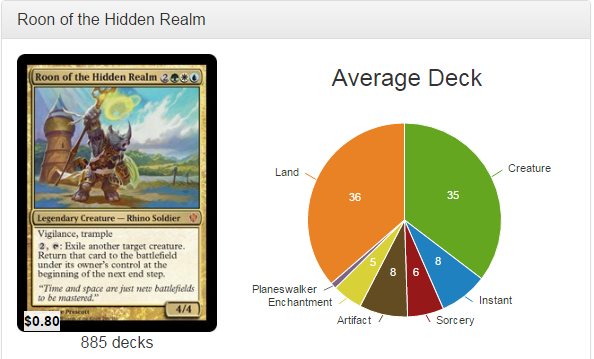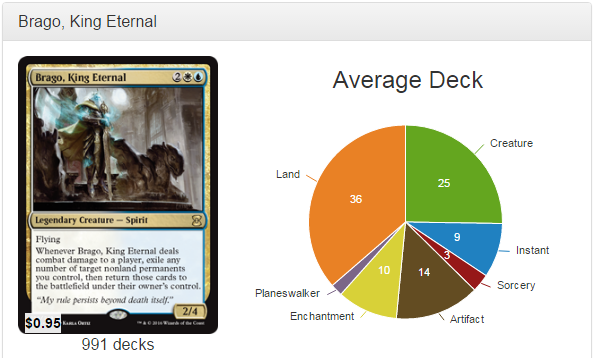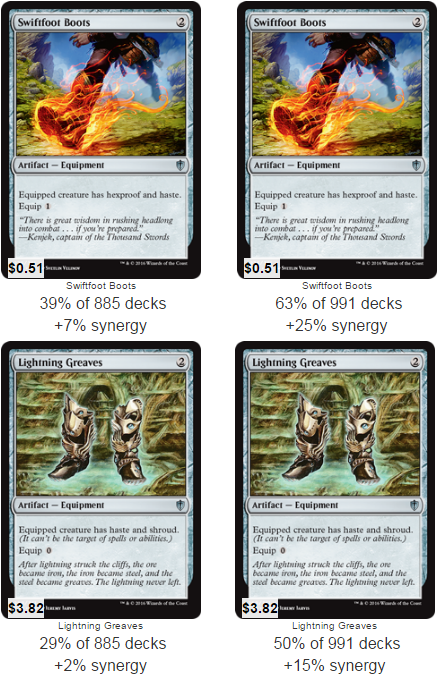Commander Showdown is a series that compares and contrast two similar commanders, analyzes differences in strategy and deck construction, and evaluates how those differences are represented by the data here on EDHREC.
Modern Masters 2017 is just around the corner, and the set is chock full of amazing cards and sweet draft archetypes. The one that catches my eye is the white-blue pair, which Adam Prosak’s article described as “White-Blue Blink – Use creatures with enter the battlefield abilities and ways to reuse these abilities.” In anticipation of playing this awesome strategy in Limited, I’d like to spend this week’s Showdown with the most famous blink strategies in Commander: the kings of flicker, Roon of the Hidden RealmRoon of the Hidden Realm and Brago, King EternalBrago, King Eternal.
Made You Blink!
Roon and Brago are both commanders that exile permanents and return them to the battlefield, an ability commonly referred to as “blink” or “flicker.” As Prosak stated above, this strategy is most often used to repeat enters-the-battlefield (ETB) abilities. Roon's is an activated ability that requires some mana and a tap, while Brago's is a triggered ability that fires when he does combat damage to a player.
But if we look closer, these two commanders are actually very different.
Blink and You Might Miss it
The first (and most obvious) difference is that Roon is green. Depending on your point of view, a commander with three colors instead of two can either be a boon or a burden. On the one hand, three colors makes mana fixing much more difficult, while on the other, it opens your deck up to thousands of new card choices. In this particular instance, I personally find mana-fixing to be quite easy for Roon precisely because he’s green, giving him access to excellent ramp effects. By contrast, Brago’s ramp and mana-fixing needs to be primarily artifact-based.
The next big difference is that Roon’s ability only targets creatures. Brago can target any nonland permanent while Roon is limited to creatures. This necessitates a creature-heavy build for Roon decks, which means when choosing between a sorcery or a creature (for example, Rampant GrowthRampant Growth and Farhaven ElfFarhaven Elf) a Roon player will nearly always pick the creature to maximize the value.
Brago, however, is under no such constraints. He targets any number of artifacts, enchantments, or even planeswalkers. So even though Roon has access to green cards Brago can’t touch, Brago has access to cards Roon won’t touch.
In fact, let’s take a look at the average deck pie chart for each commander:

A typical Roon deck has a whopping ten more creatures than a Brago deck. Ten! That’s a gigantic difference: one quarter of your deck versus over one-third. Notice that, as expected, Brago makes up for this by having bigger slices of enchantments and artifacts.
If you’re considering building a flicker deck, this is the first big signal to help you decide which of these commanders is right for you. Make sure you ask yourself which cards you’re most excited about blinking. If you want to abuse PanharmoniconPanharmonicon by casting Eerie InterludeEerie Interlude with an army of enters-the-battlefield creatures, that’s probably up Roon’s alley. If you’re more excited at the idea of repeatedly enchanting and flickering a Reality AcidReality Acid to take out pesky permanents, Brago’s your guy.
There are two final differences I want to mention. Not only do Roon and Brago differ in types of cards they can target, but also in number of cards they can target. Roon selects one creature at a time, but Brago can choose any number of nonland permanents you control. Not only that, but the flicker effect's speed is different too: Roon returns the exiled creature at the end step while Brago brings them back right away.
This makes a world of difference for these two decks. Brago’s mana rocks suddenly become much more appealing, since he can flicker all of your rocks and bring them back into play untapped for your second Main Phase. Basalt MonolithBasalt Monolith and Mana VaultMana Vault sure are a lot better when you can blink them to bypass their downside. Planeswalkers are crazy powerful here too, since you can activate their loyalty abilities, blink them with Brago to reset their loyalty, and activate their abilities a second time that turn.
Of course, Brago’s flicker effects are largely restricted to your turn, a constraint that Roon doesn’t share. He may be slower to bring creatures back to the battlefield, but his ability can be used on any player’s turn, and on any player’s creature. In a pinch, Roon can be used to take a creature out of combat to keep you alive. Also, since his blink has a delay, he can even save a creature from a Wrath of GodWrath of God. Roon may be a very creature-based deck, but that doesn’t stop him from being a trickster in his own right.
Venn Diagram Time
Ultimately, none of this musing gives us as much information as the data, so let’s get to the fun part. Below is a chart comparing the Top and Signature cards for each deck, to find the overlap:
| Roon | Both | Brago |
|---|---|---|
| Conjurer's ClosetConjurer's Closet | MulldrifterMulldrifter | Reality AcidReality Acid |
| Acidic SlimeAcidic Slime | Reflector MageReflector Mage | Strionic ResonatorStrionic Resonator |
| Coiling OracleCoiling Oracle | PanharmoniconPanharmonicon | Basalt MonolithBasalt Monolith |
| Mistmeadow WitchMistmeadow Witch | CloudblazerCloudblazer | Peregrine DrakePeregrine Drake |
| Farhaven ElfFarhaven Elf | Deadeye NavigatorDeadeye Navigator | Lavinia of the TenthLavinia of the Tenth |
| Brago, King EternalBrago, King Eternal | Sun TitanSun Titan | Act of AuthorityAct of Authority |
| Karmic GuideKarmic Guide | Cyclonic RiftCyclonic Rift | Spine of Ish SahSpine of Ish Sah |
| Prime Speaker ZeganaPrime Speaker Zegana | Venser, the SojournerVenser, the Sojourner | NevermakerNevermaker |
| ThragtuskThragtusk | Solemn SimulacrumSolemn Simulacrum | Stonehorn DignitaryStonehorn Dignitary |
| Eternal WitnessEternal Witness | Swords to PlowsharesSwords to Plowshares | Azorius SignetAzorius Signet |
| Reclamation SageReclamation Sage | Eerie InterludeEerie Interlude | Swiftfoot BootsSwiftfoot Boots |
| Aura ShardsAura Shards | Detention SphereDetention Sphere | |
| Angel of SerenityAngel of Serenity | ArchaeomancerArchaeomancer | |
| Avenger of ZendikarAvenger of Zendikar | Oblivion RingOblivion Ring | |
| ReveillarkReveillark | CounterspellCounterspell | |
| Eldrazi DisplacerEldrazi Displacer | Lightning GreavesLightning Greaves | |
| Wood ElvesWood Elves | Unquestioned AuthorityUnquestioned Authority |
Hexproof Ya Later, Alligator
There’s a lot to sift through here, but let’s start with a quick observation:
Swiftfoot BootsSwiftfoot Boots and Lightning GreavesLightning Greaves, two of the most popular and most-played equipment in the format, are not in the “Both” column. They’re only in Brago’s, which seems odd. Swiftfoot Boots even came in Evasive Maneuvers, Roon’s preconstructed deck, and if we know anything about the Precon Effect, it’s that players often run cards that came in the precon decks even if they’re suboptimal. Despite this, Roon decks only include the Boots 39% of the time and Greaves 29%.

This is probably the most important data on these commanders' pages, because it shows us the most significant difference between Roon and Brago:
Brago is not different from Roon because of the types of permanents he flickers.
Brago is different from Roon because he's a control deck.
Resetting those mana rocks is handy to keep up mana for instants on other players’ turns. Blinking NevermakerNevermaker can ruin an opponent’s draw step. And Lavinia of the TenthLavinia of the Tenth and Stonehorn DignitaryStonehorn Dignitary sure keep your life total intact so you can make it to the late game. (Though for the record, I think Stonehorn DignitaryStonehorn Dignitary is pretty good in a Roon deck too.)
Thus, hexproof and shroud are absolutely vital for Brago players, because they need to keep him alive. They even have CounterspellCounterspell on their Top Cards list to keep him safe. Without Brago, the deck has very few other blink effects, and loses its value engine.
Compare all of this to Roon. He doesn't care as much about hexproof because he doesn't necessarily need to stay alive to provide value. His deck of enters-the-battlefield creatures already does that. He also has more room for redundancy, with cards like Conjurer's ClosetConjurer's Closet and Mistmeadow WitchMistmeadow Witch. As a result, Roon cares more about GhostwayGhostway than Swiftfoot BootsSwiftfoot Boots, saving his whole team from a wrath, not just himself from a Path.
Win Conditions
All of this brings us to win conditions, another tricky difference between these two commanders. If we look at Roon's column, it looks pretty straightforward. You get a lot of repeated value from your creatures, and once it comes time to close out the game, you should be able to bash in with those creatures to get your opponents to 0. Given enough time, an army of ThragtuskThragtusk or Avenger of ZendikarAvenger of Zendikar tokens can be overwhelming.
Of course, Roon is no stranger to combo. His column also contains famous combo pieces like Karmic GuideKarmic Guide and ReveillarkReveillark, and who can forget the infamous Deadeye NavigatorDeadeye Navigator? Along with his friends Mistmeadow WitchMistmeadow Witch and Eldrazi DisplacerEldrazi Displacer, Roon can claim victory by paring any of these with something as simple as an Acidic SlimeAcidic Slime.
Brago, on the other hand, does not appear to have much in the way of face-bashing. Per his role as control, he largely has two main win conditions: infinite combos and stax.
This is pretty apparent by looking at his column. Combine Brago's triggered ability with Strionic ResonatorStrionic Resonator and a Basalt MonolithBasalt Monolith and you can generate an infinite amount of mana, along with any other triggered abilities you have on the battlefield. Pair that Peregrine DrakePeregrine Drake in his column with the aforementioned Deadeye NavigatorDeadeye Navigator and you can do the same. Since Brago has so few creatures, and not a lot of power himself, locking down the board until you draw into your combo is his primary game plan.
Of course, this also means that you need to securely lock down the board, which is why another of Brago's main path to victory is a stax strategy. These cards may not show up on his Top or Signature Cards, but dig around on Brago's page and you'll find StasisStasis, Winter OrbWinter Orb, Static OrbStatic Orb, and Tangle WireTangle Wire.
Who cares about untapping only one permanent when Brago can bring all your artifacts back onto the battlefield untapped? If you keep resetting the fade counters on TanglewireTanglewire, your opponents have to tap more permanents than you do every turn, which means you'll accumulate an advantage over time.
That is kind of the problem, though: time. I won't go so far as to say Roon is a quick deck, but he's nowhere as slow as Brago. Brago, especially competitive lists, can really drag out the game. If you're choosing between these two commanders, I can't stress enough how important it is to know how you want to win the game. If you're the kind of player who has the patience (and a playgroup with the patience) to run out a StasisStasis lock, Brago might be right for you. But if you really just want to blink a few things and bash some face, Roon may be more worthwhile for your playstyle.
Cards to Consider
Last up, I'd like to suggest a few cards that don't see as much play in these decks as I think they should.
Roon
- Cauldron of SoulsCauldron of Souls. This card is a total blowout, and I'm shocked that Roon players aren't running it. Save your board from a wrath? Check. Get additional enter-the-battlefield triggers? Check. Flicker your creatures so they lose the -1/-1 counter and can get Persist again? CHECK.
- Knight-Captain of EosKnight-Captain of Eos gives you dudes and lets you sacrifice them to fog for a turn. This is the white version of Spike WeaverSpike Weaver and it's very good to keep blinking.
- Perplexing ChimeraPerplexing Chimera. This card is usually associated with decks like ZedruuZedruu, but it's actually brilliant for Roon. If an opponent plays something you like, you can nab it from them, then blink the Chimera back to your side of the field, ready to steal another spell.
- Rite of ReplicationRite of Replication. I mentioned this card in my last article, but I'm gonna plug it again here. So what if tokens can't be flickered? This card represents five enter-the-battlefield triggers, and that's exactly what Roon wants.
- I can't believe I have to say this but Bant CharmBant Charm. Not because of synergy, but just because it's one of the best charms in EDH. It's artifact removal. It's creature removal, even indestructible ones. And it can stop a Chaos Warp in its tracks. The utility here is just too good to pass up.
Brago
- TreacheryTreachery. Is. Insane. Why exile an enemy creature with Oblivion RingOblivion Ring when you can steal that creature and untap your lands instead?
- Mystic RemoraMystic Remora. Resetting the counters on this card is really, really good.
- Glen Elendra ArchmageGlen Elendra Archmage is a repeatable counterspell.
- Planeswalkers, generally. Venser, the SojournerVenser, the Sojourner is a Top Card, but he's not the only good one out there. Tezzeret the SeekerTezzeret the Seeker and Teferi, Temporal ArchmageTeferi, Temporal Archmage only have 34% and 17% popularity on Brago's page, and that number should be much higher. Both provide excellent value, especially when you get to use their abilities multiple times a turn.
- Prophetic PrismProphetic Prism. Is this card kinda janky? Sure. But Ichor WellspringIchor Wellspring has a higher percentage than this card and that's just plain wrong. Prism will draw you cards and fix your mana. Leave the Wellspring to the Breya, Etherium ShaperBreya, Etherium Shaper and Daretti, Scrap SavantDaretti, Scrap Savant decks. Here in Brago's realm we're blinking artifacts, not sacrificing them, and with all the colorless mana he can make from that Strionic ResonatorStrionic Resonator and Basalt MonolithBasalt Monolith combo, it's actually useful to be able to make some of it white or blue.
In the Blink of a Deadeye
It always tickles me to see EDH cards show up in non-EDH formats, so I'm excited to see what happens with things like Deadeye NavigatorDeadeye Navigator in Modern Masters 2017. And if, after you draft the set, you still want to play more blink, Roon and Brago might be able to help you out. But watch carefully–like all magicians who make things vanish into thin air, these commanders are not as simple as they first appear.
Until next time!
Joseph Schultz
Joey is the lead editor and content producer for EDHREC. You can find him hosting and creating tons of great videos over at https://www.youtube.com/edhrecast or give him a follow at @JosephMSchultz on Twitter, where he likes to celebrate Commander, coffee, and corgis.
Your opinions are welcome. We love hearing what you think about Magic! We ask that you are always respectful when commenting. Please keep in mind how your comments could be interpreted by others. Personal attacks on our writers or other commenters will not be tolerated. Your comments may be removed if your language could be interpreted as aggressive or disrespectful. You may also be banned from writing further comments.
